Real Space (Sculpture):
The impulse to sculpt is the impulse to sculpt. Coitus with the materials is a question of loving the one you’re with. Available materials and the techniques acquired from teachers put a stamp on things. The intellectualist cachet of certain materials and technologies conferring the status of high art is probably no longer environmentally sustainable. With generations of quarrying and mining the earth’s crust must be as frail as choux pastry by now.
The same intellectualist stance blinds celebrants of world art “busts” to the scenographic, that is to say: shamanistic purpose of these masterpieces. Look carefully: you will find the piercings at the base of Nigerian effigies that facilitate stitching onto cushions worn on the crown of the performer’s head. Look carefully: you will find the channels through which the marionette strings of the British Columbian Raven transformation masks fit.
Textiles are perhaps the most ubiquitous of materials with the greatest technological diversity. The French textile industry of the 18th century developed the proto-digital computer. Yet, contemporary North American attitudes toward textiles are sexist, class-conscious and wasteful. Poets attempting to use the language of textiles use only its banalities. We have outsourced the work of clothiers to children in the developing world who are deprived of schooling and expect to purchase frocks at a fraction of a weekly grocery bill. North Americans throw garments away because a button is missing. We have created an economy in which a clothing mechanic is an unheard of concept, while we spend substantial amounts of our monthly salaries on car and computer maintenance.
To return on topic: Other than my mother, my sculptural parents were the New Yorkers of the theatre: Fred Nihda, David Manwaring, the millinery team of Brooks Van Horn Costume Company that created the Ringling Circus costumes, the Ray Diffen team for boned corsets and wired tutus of the ballet. Two kinds of materials, essentially: textiles and wire armatures. Whether as small as a masque or as large as fourteen foot high modular set unit, the principles are the same. If a structure cannot withstand stress at the scale of a maquette, the identical stress will manifest exponentially on set. Millinery is a remarkable engineering instructor! It is a set model that must be sturdy, comfortable and balanced enough to be worn by an acrobat.
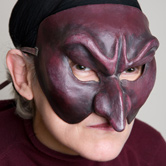
Pantalone mask as angry figure. Celastic, wire, acrylic paint. New York: Mask-Making with Frederick Nihda, 1976. Photo: Mina Momeni, 2012. |
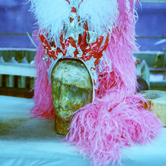
Ringing Circus Chorine Headdress. B-Team refurbishing. Wired Buckram, sequined moleskin, wired coq feathers, wired ostrich plums, Designer: Don Foote. New York: Brooks Van Horn, 1979. The previous year’s B-Team costumes reeked of animal scent. |
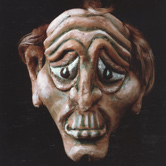
Don Quixote as Fool. Celastic, wire, acrylic paint. CSU—Fresno, 1980. |
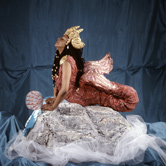
Leap into Summer. Emerita Emerencia as La Sirène. Canvas, Pencil Wire, Boning, milliskin, shot organdy and notions. Photo: Susanne Jeffery, 2004 for La Scénographie de la Sirène. The School of Image Arts Gallery. |
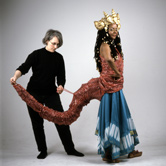
La Sirène: Tail Extended. Photo: Susanne Jeffery. 2004 |
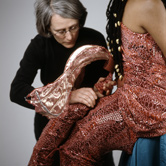
La Sirène. Hooking the Fin. Photo: Susanne Jeffrey. |
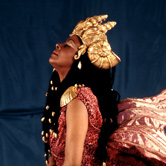
La Sirène. Headdress. Papier maché in negative mould, aluminum screening, wire, string, parchment, sea horses, purchased wig, pistachio shells, seashells, acrylic paint. 2002. Photo: Susanne Jeffrey Detail |
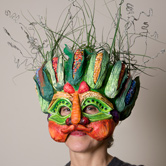
Food for Thought. Headdress based on Archimbaldo for Emerita Emerencia. Papier maché in positive mould, lentils, plastic grasses, crêpe brown paper. Prologue for the Performing Arts: Toronto, 1996. Photo: Mina Momeni, 2012. |
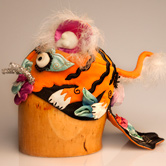
Tigre Protection Hat for Emerita Emerencia. Black canvas, and knitted fleece padding, silk fabric and ribbon, wire, ostrich flu, google eyes, rick rack, cording, embroidery floss. Featured in Celebrating Virtue: Prestige Costume and Fabrics of Late Imperial China. Toronto: The Textile Museum of Canada, 2001. Photo: Mina Momeni, 2012. |
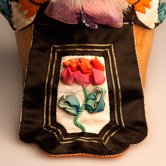
Tigre Protection Hat for Emerita Emerencia. Featured in Celebrating Virtue: Prestige Costume and Fabrics of Late Imperial China. Toronto: The Textile Museum of Canada, 2001. Photo: Mina Momeni, 2012. |
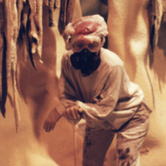
Valérie in protective gear, clowning with her “conductor’s baton” among set pieces in progress for “The Crystal Cave.” Groundling Marsh III. Wooden armature, aerated foam and felt. Sprayed with two-part insulating foam. Toronto: Portfolio Film and Television; John Delmage Productions, 1995. The sub-contractors needed a little aesthetic guidance. Possibly the most toxic project other than making fibre glass armor with David Manwaring. Quick results mean greater toxicity. Safer methods require time. |
|
^ back to top of the page
How to cite these works
| CMS |
Kaelin, Valérie C. “Name of Work,” medium, date. In Valérie C. Kaelin Website; Art; Hand; Real Space; January 6, 2013. Accessed Month, Day,Year. http://www.valeriekaelin.com.
|
| MLA |
Kaelin, Valérie C. Name of Work. Medium. Year. Web. Add Day, Abbreviation for the Month, Year. |
|

